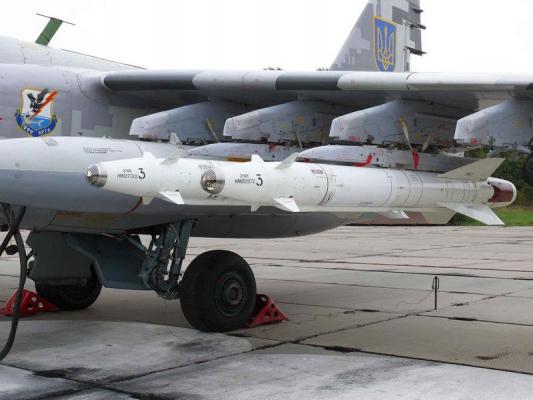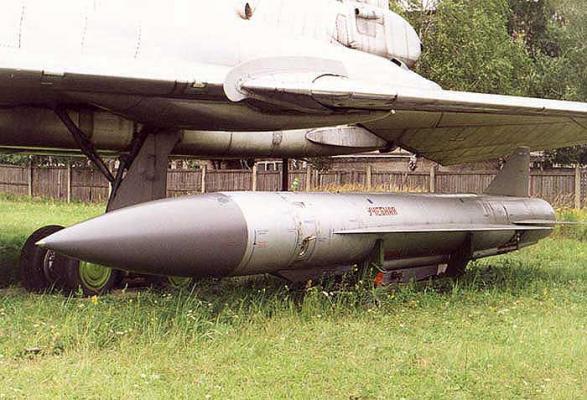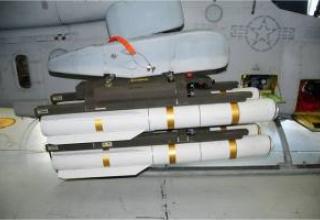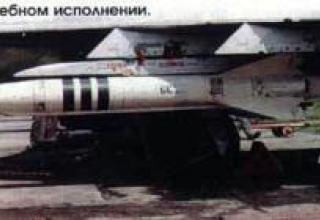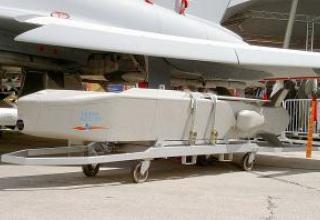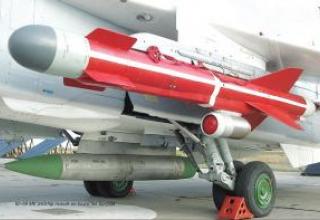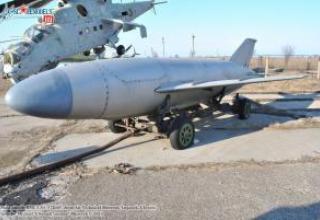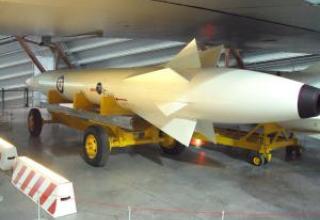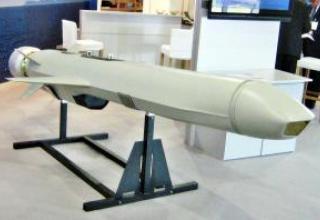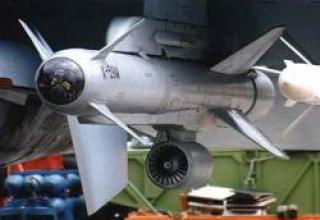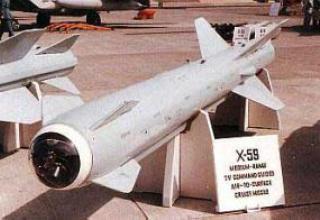X-25ML aircraft tactical missile with laser homing head is designed to engage small mobile and stationary ground (surface) targets: radar and launchers of ZUR complexes, aircraft in open parking lots and in light shelters, light bridges and crossings, lightweight ships, railway trains and other targets.
The X-25ML rocket, which is part of the modular series of X-25M air-to-ground tactical missiles, was developed by the Zvezda Design Bureau in accordance with the USSR Council of Ministers' resolution of 1978.
The idea to create the Kh--25M missile family was born from the experience of development and serial production of the previous generation of guided missile weapons, created by the team of this design bureau. Work on the X-23, X-25 and X-27 missiles revealed their significant commonality in the main subsystems. The essence of the new modular concept of X-25M implied the allocation of missiles for various purposes common subsystems that form a single basic module, which are connected to replaceable modules for products for various purposes. The application of the modular principle of missile design ensured the reduction of time for the development of new products, the cost of testing them, simplified the adaptation of each type of weapons to different aircraft carriers, reduced the total cost of retraining of personnel in the troops, facilitated maintenance of operating organizations.
The main principles laid down in the ideology of building a modular X-25M missile were:
- Replacement of three missiles in production: X-23M, X-25 and X-27PS by one missile with interchangeable guidance systems;
- The possibility of forming the necessary shape of the missile directly in combat units;
- The possibility of improving this class of weapon through the use of new types of combat units and advanced guidance systems.
The creation of a modular missile should have been possible:
- to reduce the number of missile types;
- significantly reduce the cost and time required to develop new guided missile weapon systems;
- shorten the mobilization deployment cycle for a specific period;
- to create a family of modular elements of weapon systems with sufficient adaptation to the dynamic situation in the theatre of war;
- to increase the operational reliability of weapon systems;
- to simplify their operation.
At the first stage, it was planned to unify the missiles X-23M, X-25 and X-27PS, and in the future to develop new versions of modules for the missile GOS and combat equipment.
The modular series included missiles:
- X-25ML - with laser homing head;
- X-25MR - with a radio command guidance system;
- X-25MP - with a radar passive head of homing.
Aircraft carrier: MiG-23BN, MiG-23BM, MiG-27M, MiG-27K, MiG-27D, Su-17M2, Su-17M3, Su-17M4, Su-24M, Su-25, Su-25T, Yak-141, MiG-29M, Su-35.
The first production missiles were delivered to the customer in 1982. The peak of mass production occurred in the second half of the 1980s. After the collapse of the Soviet Union, only X-25ML missiles were in production, the output of which decreased significantly. The last missiles were manufactured in 1997. A total of about 25,000 X-25M missiles were produced, of which more than 5,000 were exported to 15 countries. Order № 0209 of August 13, 1989 the Minister of Defense of the USSR missiles X-25MP, X-25ML and X-25MR were adopted for service. It was the most massive Soviet air-to-surface missile, both in terms of production and the number of aircraft armed with it.
In the west, the missile was designated AS-10 "Karen".
Composition:
X-25ML rocket (product 713) is made according to the aerodynamic scheme "duck" with an X-shaped arrangement of the wing and rudders (see projections). Dual-mode engine PRD-276 on mixed fuel was developed in OKB-81 under the guidance of I.I.Kartukov. The F-27 high-explosive combat unit is located in the forward part of the glider behind the WGSN and in the tail compartment behind the propulsion system.
The missile has a 24N1 semi-active laser homing head (see photo), which is also used for X-29L and S-25L missiles included in the Su-17 (various modifications), Su-24M, MiG-23BM and MiG-27K aircraft.
The aim of the X-25ML missile is based on the proportional approach method. The control parameter is the angular rate of change in the target sighting line direction. The control signal is formed at the output of the laser target tracking coordinator, having a field of view angle - 2o, the maximum angle of target bearing - 30o. The control system also stabilises the missile in pitch, heading and roll.
The target can be illuminated by an onboard or ground target designation station. In order to ensure target illumination and retention of the laser beam with the required accuracy, the Klen-PS illumination and rangefinder station as well as two modifications of the Kaira and Kaira-K laser and television sighting systems were created. In the designs of the illumination station and GSN there were implemented technical solutions excluding the influence of laser radiation from other aircraft in the group. The pilot's task is only to detect and mark the affected object on the TU-indicator. An automatic tracking system ensures accurate retention of the illumination beam on the target. A complex of opto-electronic devices from the illumination station and SOS provides guidance of missiles with an error of 5-7 m at the limiting ranges of fire. The missile makes a "slide" on the final part of the trajectory.
For transportation and storage of the missile a special container is used.
X-25ML is used in weapon systems "Searchlight", "Kaira", "Maple", "Squall", including:
- laser target illumination station;
- up to four X-25ML missiles;
- aircraft launchers ACU-68UMZ and ACU-68UM2;
- control and test equipment.
The "Searchlight" weapon system is used by Su-17M2, "Kaira" - Su-24M, Su-24MK and MiG-27K, "Maple" aircraft. - Su-17MZ, Su-17M4, Su-22MZ, Su-25, Su-25K and MiG-27M, "Shkval" - Su-25T. All the aircraft can accommodate up to 4 missiles (except for the Su-17M2, which accommodates 2 missiles). In addition, the flight tests of MiG-29M confirmed the ability to use X-25ML missiles.
Characteristics:
| Developer | OKB "Zvezda" |
| Manufacturer | SSC "Star Arrow" |
| Range, km | |
| minimum | 2.5-3 |
| maximum | 10 |
| Flight time at maximum range, s | 15-18 |
| Flight Speed max. m/s | 870 |
| Flight Speed average, m/s | 400-450 |
| Flying speed of the carrier, km/h | 600-1250 |
| Launch height, km | 0.05-5 |
| Firing Precision (KBO), m | 5-10 |
| The length of the rocket, mm | 3705-3750 |
| Maximum rocket body diameter, mm | 275 |
| Wingspan, mm | 820 |
| Finger scale, mm | 493 |
| Start weight , kg | до 310 |
| Weight of combat unit, kg | 86 |
| Transport container | |
| length,mm | 4200 |
| width,mm | 860 |
| height,mm | 806 |
| rocket container weight , kg | 540 |
Testing:
The X-22 missile proved to be a very effective anti-ship vehicle even without a nuclear charge. Tests have shown that in the event of a sea target being hit, the X-22 would cause damage to the target ship, which could disable an aircraft carrier or cruiser. At the take-off speed of 800 m/s, the area of the hole was up to 22 sq.m., and the inner compartments were burned by a cumulative jet to a depth of 12m.
The Soviet leadership considered the aircraft Tu-95K-22 and Tu-22M3 with the X-22 rocket the most effective tool to combat aircraft carriers. Therefore, Soviet heavy aircraft systematically approached the U.S. aircraft carriers and recorded the action of radio electronic interference Americans. According to navigators, the effectiveness of these tools was tremendous: the target markings on the screens literally drowned in a cloud of interference, it became impossible to aim. Therefore, a version of the attack was developed, according to which the first to launch X-22 missiles with nuclear warheads are not on specific targets, and the area where the American aircraft carrier connection was to be. It was believed that after that the action of electronic countermeasures will significantly reduce, and the second wave of X-22 missiles will find surviving targets.
Measures to overcome the air defense included a variety of tactical techniques: massaging efforts of several strike groups, echelonizing the combat orders of missile carriers and air defense aircraft that covered them, maneuvering during an attack. The strike could be delivered by reshaping several units and launching from different directions, frontal attack with salvo launch of dozens of missiles, consecutive disabling of cover ships, weakening of the air defense and defeating the main target. Sometimes a distraction group of aircraft stood out. During combat training, the targets were real AUGs, which were within the reach of missile-borne units. The appearance of potential enemy ship groups near the Soviet shores usually served as an excuse to work out a plan of counteraction with training anxiety and regimental flight. During daily training, crews were limited to tactical launches.
Until the beginning of the 90s, the crews of both YES and Navy conducted combat firing at sea targets in the Caspian Sea, for which the crews from remote airfields moved closer to the firing range during training sessions. Mozdok usually served as a base for "long-range" airfields, and Oktyabrskoye in Crimea served as a base for "sailors". Over time, the range in the Caspian Sea, which had been in operation since the 50s, was closed by environmentalists' demands due to the contamination of the sea with countless missile debris. Problems have also arisen with the organization of shooting at the Akhtuba range, which is now under Kazakhstan's control.
With the removal of weapons Tu-22K and Tu-95K-22 missile system K-22M continued to remain in service, using the aircraft Tu-22M3 - the most modern machines of this type. Equipped with these parts are the basis of the missile forces of the YES and the Navy in Russia and the Ukraine. By 1994, there were 92 aircraft of this type in Ukraine and the Crimea.
In April 1987, the forces of the Russian YES were consolidated into the 37th FA of the Navy. To date, the Tu-22M3 are in service with four of its air regiments, as well as two maritime missile-bearing regiments on the SF and TOF (in the early 80's at the height of Soviet aviation fleet had a fleet of one and a half dozen missile-carrying regiments).
After several years of uncertainty, rocket firing at newly equipped firing ranges also resumed (their arrangement was linked not only to the choice of small, extensive locations for safety requirements in case of missiles or irregular missile behavior, which sometimes happened, but also to the equipment of measuring posts and telemetry control points). For the first time, the Tu-22M3 of the Severomorsk Kirkenes Red Banner Air Division carried out missile launches in the Barents Sea during the Zapad-99 command and staff exercise in northern Russia. Striking together with the missile ships of the fleet, 24-26 June 1999 TU-22M3 "destroyed" detachment cover enemy ships at a range of 100 km, and the "main target" - with 300 km. In September the same year, the TU-22M3 detachment conducted missile firing at targets four X-22.
During a joint exercise of the Air Force of Russia and Ukraine August 11, 2000 a pair of Poltava Tu-22M3 made a five-hour flight to the North and together with 10 Russian aircraft attacked targets at the testing ground near Novaya Zemlya. Although only three pilots had participated in the launches before due to the long break, both target barges were hit.
Two weeks later, on 25th August 2000, the crew of the Ukrainian Tu-22M3 performed an unusual task: providing joint exercises of the Air Forces and Air Defence at the Arkhalyk range, after a long flight it fired an X-22 target missile successfully intercepted and hit by Su-27 fighters.
On 6 April 2001, during a major exercise of the 37th Air Force combined with the Yuzhny Shield-2001 KShU, the X-22 was launched, which was of research nature: a missile that had been stored in a warehouse for 25 years was taken to check reliability. Launch from the board of the Tu-22M3 at the Makat test site was a success, all systems of the X-22 worked off routinely. Less successful were the shooting at the new range near Chita in September 2002 - due to failure in the guidance missile fell in Mongolia, causing a scandal and demands for millions of compensation (the same slippage took place in Kazakhstan, where the X-22 fell near the village).
The X-22 took an exceptional place in domestic aviation and rocket technology - both in terms of the service life of the complex, approaching the 40-year mark, and the universality of application. Unlike other missiles of its class, whose service was limited to a single type of aircraft (in turn, a special modification of which was created for a certain complex of missile weapons). X-22 was armed with three carrier aircraft - Tu-22K, Tu-22M and Tu-95K-22.
However, the long service and improvement of the complex could not save it from a significant disadvantage - low serviceability associated with the use of liquid rockets. The high performance achieved by the use of liquid-propellant missiles, brought with it organic flaws and problems with ensuring the combat readiness of missiles, which required equipment with toxic and caustic components - acid and no less harmful fuel.
Prolonged storage in refueled form proved to be unacceptable due to corrosion resistance of the structure. The use of protective coatings and inhibitors - corrosion retardants - also prevented this threat from being radically eliminated. At one time, the solution was to organize a continuous cycle of work on missiles, in which at the expiration of the period of maintenance of fuel and oxidizer refueled AKR from them, removed BC, the tanks were washed with neutralizing solution, dried, and the missiles were put in storage, while the next stage of the AKR after the equipment was ready for combat duty. The labor-intensiveness of such a "carousel" with maintenance of constant combat readiness created too many obstacles; and the main direction was to improve the refueling technology, which accelerated the process as much as possible and simplified it with due security.
The most effective measure was the introduction of ampoule filling with a special unit. The oxidizer from its sealed pressure vessels was pumped into the rocket tanks, remaining virtually isolated from the environment. Filling was carried out just before firing, and storage of the missiles was no longer permitted. The equipment of the rocket technicians included a protective special suit with a woolen suit to be worn under it, thick rubber gloves on top of ordinary knitted ones, and bashila boots in a thick finger. The equipment was equipped with an insulating gas mask, and the filling process was controlled by a gas analyzer in case of leakage. Labor-intensive operations in combat units were avoided as much as possible, and flights with unpacked missiles became a common practice even at the exercises. In full, their training was carried out only when offsets launches were carried out, at best, during training sessions 1-2 times a year. Shooting was an event, and in practice, given the responsibility, only the most trained crews with similar experience were allowed to fly. The training usually took at least one month, with several rehearsals. The launch always took a couple in which a substitute crew provided backup in case of refusal. Sometimes volley launches were made by a pair of missiles or both crews, including X-22 of different types with radar and inertial guidance.
Sources:
- А.В.Карпенко, С.М. Ганин "Отечественные авиационные тактические ракеты", "Бастион" N1, 2000г.
- Широкорад А.Б. "История авиационного вооружения", -Мн.: Харвест, 1999.-560с.

